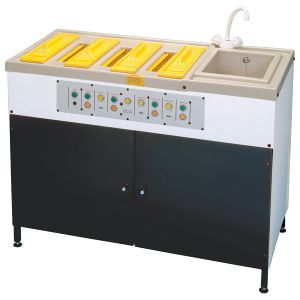Difference between revisions of "Equipment/PCB etch station"
Jump to navigation
Jump to search
(→Status) |
|||
| Line 9: | Line 9: | ||
* Do not dip a basket soaked in one chemical into the tank of another chemical. | * Do not dip a basket soaked in one chemical into the tank of another chemical. | ||
* Read the [[Media:PB BENCH Line and PCB Labstation instructions.pdf|instructions (pdf)]] | * Read the [[Media:PB BENCH Line and PCB Labstation instructions.pdf|instructions (pdf)]] | ||
| + | * '''CLEAN UP AFTERWARDS''' | ||
==Less important warnings== | ==Less important warnings== | ||
Revision as of 20:35, 4 June 2011
Important Warnings
- Do not run any heater unless the tank is full of liquid. It should blow a thermal fuse before melting the tank, but that may involve replacing the heater. Keep unused heated tanks full of plain water or disable the heaters by unplugging the associated connector inside the cupboard door.
- Do not etch anything except copper (other metals will pollute the etchant).
- Do not drink the contents, even when there's no beer.
- Do not allow children or drunken hackers to play with the tanks.
- Check the power has been turned off after use.
- Do not dip a basket soaked in one chemical into the tank of another chemical.
- Read the instructions (pdf)
- CLEAN UP AFTERWARDS
Less important warnings
- You normally place boards to be etched in the plastic basket under a tank lid, then dip it into the tank. If the PCB is too close to the open end, it will fall out. You may have to drain the tank to retrieve it. You don't want to do this, so put the pcb well into the opening and don't tip it forwards as you remove the basket from the tank.
- Very small PCBs may fall through the holes. A possible solution is to put them in fine-mesh envelopes before putting them in the basket. Finding a suitable envelope is left as an exercise for the user (hint - look on the Mega website).
Status
Etch tank bubbling fixed with a replacement pump
Todo
Next
Add a pipe clip to the cold water feed so the pipe is properly supported- Screw the wooden block mounting the pipe clips to the wall. Block already drilled, just needs someone with some rawlplugs, big screws, and a yen for using a hammer drill. Please don't drill the pipe in your enthusiasm.
Soon
- Scrub out sink
- Connect hot water to tap. Probably not really needed since there's an adjacent sink, but would complete the job.
Usage configuration
- Since it's already stained there's no problem in putting ferric chloride in it if we have some available (it needs 5 litres but 3 or 4 would do).
- We can use a spare tank to start brewing the cupric chloride if we want to do that
Placement
- It would be nice to have power without using the extension lead. The existing ring main might be extended fairly easily to put sockets on the wall near the sink.
- Again, depending on when electrical stuff is needed, I could go out and get conduit/socket/back box/etc. on Fri/Sat. -- Elliot
- I see there's a bit of conduit near #23 back door. Needs a socket plate and probably some more 2.5mm wire to link into the ring. Could be patched up but a better plan might be to look at fixing a couple of electrical jobs and buy the bits at the best price rather than in small pieces.
Model
- Make: Mega Electronics
- Model: PB710S - PCB 7 tank production line with sink
Controls
The leftmost button on the control panel is mains power. If you see it lit up when no-one is using the tank, please turn it off (but if someone _might_ be waiting for it to warm up, please check first!). Probably a good idea to switch off at the mains as well.
Each tank and rinser then has a control section. Working from left to right, these are:
- Developer - Heat button and 'heater active' light. Set to about 28°C. Heating not normally required.
- Developer rinse - Spray button activates spray bar.
- Etch - Heat button and 'heater active' light. Set to about 48°C. Takes about 15-20 minutes to get hot.
- Air bubbler button - only active when heating is also on.
- Etch rinse - Spray button activates spray bar.
- Photoresist stripper - Heat button and 'heater active' light. Set to about 50°C. Optional.
- Stripper rinse - Spray button activates spray bar.
- Tinning - Heat button and 'heater active' light. Set to about 50°C. Optional.
The spray bars work best if only one is on at a time (and unless you're making a lot of boards at once, you probably only need one).
Instructions
The tank was previously in a school and there is a laminated sheet with usage instructions. It may not be applicable to our use but is worth looking at.
- Manufacturer's instructions (local copy)
- Heater and bubble bar Maintenance - also see Mike's posting on mailing list.
- Ferric Chloride
- Stain remover
- Fine etch crystals - we don't use this at present but it's been suggested.
- Photoresist stripper
- Tin plating - We have a small tub of this, possibly unusably old.
- All Mega MSDS and data sheets
